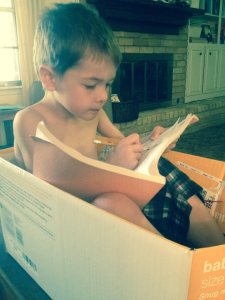A friend of mine recently posted this picture of her son, clearly engaged in his homeschooling homework while sitting in a box– thinking inside the box, if you will.
Homeschooling Gets a Second Life
Homeschooling is on the rise. Its focus on individualized attention, teaching to your child’s strengths, going at your own pace, and making learning come to life is getting a second wind. In fact, I can think of at least five friends and family members who have chosen to homeschool their children.
Whether it’s a response to the public school class size (up to 40!) or pricey private school alternatives, homeschooling provides a chance to dig into the subject matters that interest your kids the most while allowing your child to explore and think creatively without the confines of a classroom.
There is no one-size-fits-all education. There never was. Traditional, Public, Developmental, Progressive, Therapeutic and the Unschooling Movements
Traditional schools teach to the middle while developmental, progressive, therapeutic and especially the unschooling or non-schooling movement embraces the idea that teaching to the individual is the preferred route to take. Where homeschooling is not an option, I’ve guided many parents towards these alternative school choices.
Let’s walk through these various school movements using Sara, a slow reader, as an example.
- Public Schools set the traditional model standard. They focus on standardizing objective criteria, pulling from data to ensure that all students are learning within the normal range. So for someone like Sara, who is a slower reader and would likely fall outside of that standard deviation bell curve, her reading scores would put resource teachers on notice that Sara may need extra interventions. An SST (Student Success Team) Meeting as well a potential IEP (Individualized Education Program) may be the next steps to seek.
- Developmental Schools focus on allowing the child to learn according to their own development. For example, just because Sara is a slower reader than Grayson is not cause for alarm (at least not yet). The developmental movement allows time for each child to learn at their own pace.
- The Progressive School is the antithesis of the traditional public school. It agrees that Sara is a slow reader but instead of seeking remediation it will focus on Sara’s strengths, let’s say in her case — math. By playing up Sara’s awesome math skills, she will gain more overall confidence and learn to naturally compensate for her slower reading levels. Individual study and strength-based education are two hallmarks of the progressive movement.
- Therapeutic Schools are great for kids who have learning differences, behavior challenges, and social skills needs. These schools cater to students that need extra attention outside of their studies. They usually have well-rounded academics coupled with a focus on Social-Emotional Learning (SEL). So if Sara’s slow reading turns out to be dyslexia or a processing disorder coupled with ADHD this school would be able to address all of those concerns.
- And finally, the Un-Schooling or Non-Schooling Movement. This is a controversial form of education, whereby a child completely chooses his or her educational programming. In fact, the choice not to choose is also a choice recognized by this movement. For self-directed learners or gifted kids who are not being challenged in the classroom, this may be a good option. For Sara who struggles with reading, she would likely just choose not to engage in any reading. The outcome could go one of two ways: (a) Either Sara chooses to forgo any reading and instead focuses on her love of math and art, or (b) Sara learns to independently compensate for her low reading skills by using visuals, project-based learning, and books-on-tape.
What’s Most Important for Your Child’s Education?
The thing that gets me about traditional schools in this day in age is not the rigorous academics (I think that’s a good thing) but the superfluous stuff, like busy work, learning to line up, walking down a hallway in a quiet manner, and asking to the go to the bathroom before being able to leave your desk. There’s only so much modeling you need to understand social conventions.
Traditional school formats were once a preparation tool for learning to be a productive member of the industrialization era. But today, technology and the internet has opened up so many more entrepreneurial doors. Instead, our focus should be a strength-based, confidence-building, creative environment where each child can learn to love learning independently but can come together naturally to share their ideas and learn from one another.
Maybe it’s not a matter of thinking inside or outside of the box. Perhaps, we just need to change the box all together.
Take a listen on NPR: Parents On The Pros and Cons of Homeschooling and check out Terry Tutors: Our School Placement Consulting Services
—
Christine Terry, J.D., is a Special Education Advocate & Founder of Terry Tutors. She created the One Comprehensive Wraparound Service for The Struggling Student, which includes Academic, Behavior, Special Education Advocacy, and School Placement services. Want to Know More? Head on over to TerryTutors.com.


You must be logged in to post a comment.